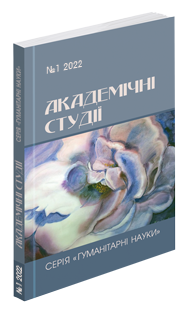Abstract
This article presents the case-study as a type of method of teaching Ukrainian as a foreign language. Its purpose is to give a detailed description of a case study – its definition, some classifications and several advantages and disadvantages – in order to provide a better understanding of this widely used type of approach. The article deals with the issue of practical use of case-study method at the Ukrainian lessons in order to improve the effectiveness of study of the Ukrainian language among future foreign specialists. The authors define the essence of the case-study method itself and the practical value of its use, suggest the examples of cases for teaching future foreign specialists in the classes of Ukrainian. The conclusion is made that the case-study method is effective enough for improving study of Ukrainian by the future foreign specialists, their ability to add to their knowledge in professionally-oriented subjects, and independently search for relevant information. Besides, the use of case-study methods at the lessons of Ukrainian improves speaking skills and their ability to present monologues and dialogues on various topics, increases vocabulary. As a result of the abovementioned research, it is considered essential to introduce the case-study method in order to improve interdisciplinary relations of professionally-oriented subjects, to develop analytic and strategic thinking, improve the ability for problem solving and making rational conclusions in the course of training future foreign specialists. The case-study method is also able to demonstrate practical value of theoretical subjects to the future specialists, and the opportunities for their realization in various true-to-life situations. Furthermore, working at the case allows future professionals to identify gaps in knowledge and close them by search.
References
Baxter P., Jack S. Qualitative Case Study Methodology: Study Design and Implementation for Novice Researchers. The Qualitative Report. 2008. 13. Issue 4. Pp. 544–559.
Flyvbjerg B. Five misunderstandings about case-study research. Qualitative Inquiry. 2006. 12. Issue 2. Pp. 219–245.
Gustafsson J. Single case studies vs. multiple case studies: a comparative study (Thesis). Halmstad, Sweden : Halmstad University, 2017. 4. Heale R, James S, Garceau ML. A multiple-case study in nurse practitioner-led clinics: an exploration of the quality of care for patients with multimorbidity. Nurs Leadersh. 2016. № 29. С. 37–45.
Inštitut za slovenski jezik Frana Ramovša ZRC SAZU, laboratorij za korpus slovenskega jezika (n.d.). URL: http://bos.zrc-sazu.si/c/neva.exe?n=a_si_s&e=C_I_D_ SM_MA%2020894
Pahre R. Formal Theory and Case-Study Methods in EU Studies. European Union Politics. 2005. № 6:1. Pp. 113–46.
Simons H. Case study research in practice. London : SAGE, 2009.
Stanford Encyclopedia of philosophy: Karl Popper. 2009. URL: http://plato.stanford.edu/entries/popper/
Thomas, G. A Typology for the case study in social science following a review of definition, discourse and structure. Qualitative Inquiry. 2011. 17. Issue 6. Pp. 511–521.
Yin R. K. Case study research: design and methods (4th ed.). Thousand Oaks, CA : Sage, 2009.

